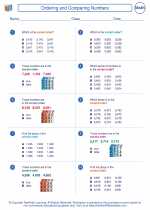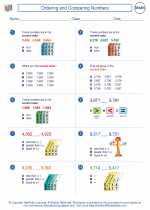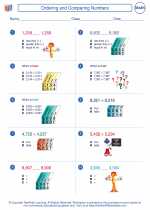Ordering and Comparing Numbers -> ordering numbers
Ordering Numbers
Ordering numbers is the process of arranging a set of numbers in a specific sequence, such as from least to greatest or from greatest to least.
Ascending Order
When numbers are arranged from the smallest to the largest, it is called ascending order. For example, the numbers 3, 7, 1, and 5 arranged in ascending order would be 1, 3, 5, 7.
Descending Order
When numbers are arranged from the largest to the smallest, it is called descending order. Using the same example, the numbers 3, 7, 1, and 5 arranged in descending order would be 7, 5, 3, 1.
Comparing Numbers
When comparing numbers, the greater than (>) and less than (<) symbols are used. For example, 8 > 5 means 8 is greater than 5, and 3 < 6 means 3 is less than 6.
Practice Example
Order the numbers 12, 6, 17, 9 in ascending order: 6, 9, 12, 17.
[Ordering Numbers] Related Worksheets and Study Guides:
.◂Math Worksheets and Study Guides Third Grade. Ordering and Comparing Numbers

 Activity Lesson
Activity Lesson
 Worksheet/Answer key
Worksheet/Answer key
 Worksheet/Answer key
Worksheet/Answer key
 Worksheet/Answer key
Worksheet/Answer key
 Worksheet/Answer key
Worksheet/Answer key
 Worksheet/Answer key
Worksheet/Answer key
 Vocabulary/Answer key
Vocabulary/Answer key
